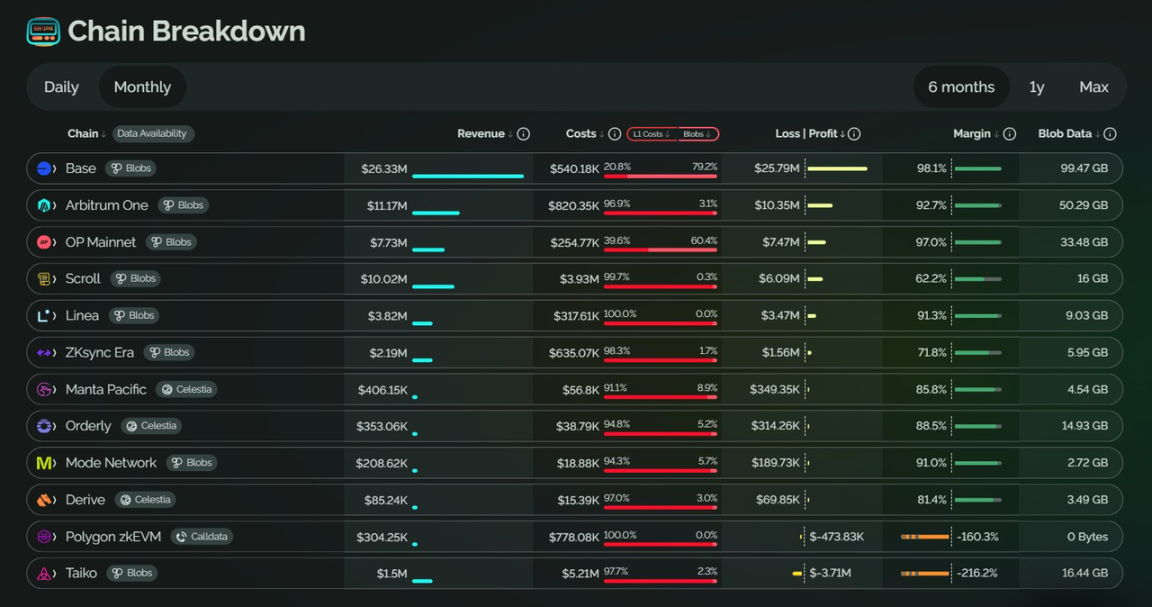Author: 1912212.eth, Foresight News
The price performance of L2 in the past has been lackluster, to the point of being nearly forgotten by the industry. However, its ecosystem continues to develop, and L2 profits have been outstanding, quietly making significant gains, with profit margins reaching as high as 98% in the past six months.
 Data source: growthepie.xye
Data source: growthepie.xye
After venture capital began betting on L2 based on OP and Arbitrum, attention has also turned to L2 built on ZKsync.
Recently, Binance Labs made a move to purchase tokens from the ZKsync-based elastic chain Sophon, attracting considerable attention once again. This round of investment concluded in August. The structure is a Simple Agreement for Future Tokens (SAFT).
The last time Sophon secured funding was in March of this year, totaling $10 million, with participation from Paper Ventures, Maven 11, The Spartan Group, SevenX Ventures, OKX Ventures, HTX Ventures, and others. In such a fiercely competitive field, what sets Sophon apart?
ZKsync-based Superchain Sophon
Sophon is a superchain based on ZKsync's Elastic Chain, and it is also an L2 based on Validium. Validium can be understood as a ZKRollup that does not use ETH as the DA layer; it utilizes off-chain DA and computation to increase throughput and reduce transaction costs. Sophon's network architecture can handle high-throughput applications such as social entertainment and gaming. By seamlessly integrating the crypto track into the platform's structure, users can enjoy the benefits of being on-chain without facing the usual complexities.
The so-called Elastic Chain is a blockchain architecture that allows for unlimited parallel expansion of network capacity by adding interconnected ZK chains while maintaining interoperability and a consistent user experience. This approach leverages recursive zero-knowledge proofs to achieve constant-time verification of computational results, regardless of how many chains are in the network. The Elastic Chain concept aims to address issues associated with traditional multi-chain setups, such as poor user experience, inefficient capital utilization, and security vulnerabilities in cross-chain bridges.
Compared to the high barriers and fragmentation of most on-chain operations today, Sophon differentiates itself in user experience by transplanting many convenient features from Web2 into Web3, automatically assisting users in account creation, key management, and transactions, allowing users to truly focus on their on-chain experience and assets. The account abstraction feature (AA) on ZKsync significantly impacts user account operations and transaction interactions, while all native account abstractions on Sophon can be transformed into smart accounts.
Additionally, Sophon is creating a system where users can easily create, share content, and profit from it, including tools for meme launches and game development.
In April of this year, sebastiena, the head of ZKsync DeFi, announced his departure from ZKsync to focus on building Sophon based on the ZK Stack. In his tweet, he expressed strong optimism for the superchain and his desire to build his own superchain. It is worth mentioning that sebastiena is also a member of the Paper Venture team.
Points and Token Economics
Currently, Sophon has opened its staking entry to earn SP points, allowing users to stake the tokens listed to earn points. According to official data, its total user count is close to 30,000, with a TVL exceeding $280 million.

The official announcement states that its mainnet will launch in Q4 of this year, along with the introduction of its token, SOPH, which will be the native token of its network used for paying gas fees. Additionally, the network will allow for a set of decentralized sequencers, with fees paid in SOPH. The final allocation, token economics, and vesting schedule for SOPH may also change.

Node rewards account for 20% of the total supply, with 25% allocated to the Sophon Foundation, 20% to seed round contributors, 5% to advisors, and 30% to ecosystem reserves.
Full Nodes and Light Nodes
Sophon currently has two types of nodes: full nodes and light nodes. Full nodes maintain a complete copy of the chain and can serve as sequencers or validators. In the early stages of the network, only one node (operated by Sophon Labs) was authorized to submit validations. The official team is working to enable multiple nodes to collaborate using a consensus mechanism, further decentralizing the network's block creation.
Light nodes are designed to perform simpler tasks within the Sophon network, with the initial version still under development. These nodes represent an economically efficient way to participate in the network, downloading only the minimum data required for transactions, typically just the block headers. In its first version, light nodes will perform DA sampling to help ensure that all data is available in the network's DA. This makes light nodes the most basic and accessible type of node, providing an entry point for users who want to interact with the network without the resource demands of running a full node.
In early May of this year, Sophon raised $60 million in WETH through a node sale.
免责声明:本文章仅代表作者个人观点,不代表本平台的立场和观点。本文章仅供信息分享,不构成对任何人的任何投资建议。用户与作者之间的任何争议,与本平台无关。如网页中刊载的文章或图片涉及侵权,请提供相关的权利证明和身份证明发送邮件到support@aicoin.com,本平台相关工作人员将会进行核查。



